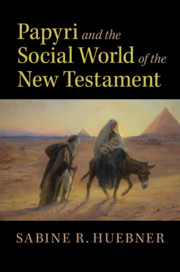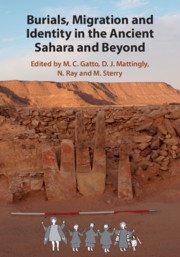Refine search
Actions for selected content:
23990 results in Ancient history
Chapter VI - “In those days Mary set out …”
-
- Book:
- Papyri and the Social World of the New Testament
- Published online:
- 08 July 2019
- Print publication:
- 11 July 2019, pp 87-114
-
- Chapter
- Export citation
Chapter VII - “In that region there were shepherds living in the fields …”
-
- Book:
- Papyri and the Social World of the New Testament
- Published online:
- 08 July 2019
- Print publication:
- 11 July 2019, pp 115-134
-
- Chapter
- Export citation
Chapter V - “The Carpenter’s Son”
-
- Book:
- Papyri and the Social World of the New Testament
- Published online:
- 08 July 2019
- Print publication:
- 11 July 2019, pp 65-86
-
- Chapter
- Export citation
Contents
-
- Book:
- Papyri and the Social World of the New Testament
- Published online:
- 08 July 2019
- Print publication:
- 11 July 2019, pp vii-vii
-
- Chapter
- Export citation
Acknowledgments
-
- Book:
- Papyri and the Social World of the New Testament
- Published online:
- 08 July 2019
- Print publication:
- 11 July 2019, pp xi-xii
-
- Chapter
- Export citation

Papyri and the Social World of the New Testament
-
- Published online:
- 08 July 2019
- Print publication:
- 11 July 2019

Burials, Migration and Identity in the Ancient Sahara and Beyond
-
- Published online:
- 21 June 2019
- Print publication:
- 14 February 2019
Chapter 6 - The Persian Conquest of Egypt
-
- Book:
- Greek Military Service in the Ancient Near East, 401–330 BCE
- Published online:
- 10 June 2019
- Print publication:
- 20 June 2019, pp 148-175
-
- Chapter
- Export citation
Chapter 5 - The Revolt of Artabazus
-
- Book:
- Greek Military Service in the Ancient Near East, 401–330 BCE
- Published online:
- 10 June 2019
- Print publication:
- 20 June 2019, pp 119-147
-
- Chapter
- Export citation
Timeline
-
- Book:
- Greek Military Service in the Ancient Near East, 401–330 BCE
- Published online:
- 10 June 2019
- Print publication:
- 20 June 2019, pp xvii-xx
-
- Chapter
- Export citation
References
-
- Book:
- Greek Military Service in the Ancient Near East, 401–330 BCE
- Published online:
- 10 June 2019
- Print publication:
- 20 June 2019, pp 236-257
-
- Chapter
- Export citation
Chapter 3 - Greece and the Rebellion of Cyrus the Younger
-
- Book:
- Greek Military Service in the Ancient Near East, 401–330 BCE
- Published online:
- 10 June 2019
- Print publication:
- 20 June 2019, pp 64-87
-
- Chapter
- Export citation
Maps
-
- Book:
- Greek Military Service in the Ancient Near East, 401–330 BCE
- Published online:
- 10 June 2019
- Print publication:
- 20 June 2019, pp x-x
-
- Chapter
- Export citation
Acknowledgments
-
- Book:
- Greek Military Service in the Ancient Near East, 401–330 BCE
- Published online:
- 10 June 2019
- Print publication:
- 20 June 2019, pp xv-xvi
-
- Chapter
- Export citation
Dedication
-
- Book:
- Greek Military Service in the Ancient Near East, 401–330 BCE
- Published online:
- 10 June 2019
- Print publication:
- 20 June 2019, pp v-vi
-
- Chapter
- Export citation
Figures
-
- Book:
- Greek Military Service in the Ancient Near East, 401–330 BCE
- Published online:
- 10 June 2019
- Print publication:
- 20 June 2019, pp ix-ix
-
- Chapter
- Export citation
Chapter 2 - The Battle of Cunaxa
-
- Book:
- Greek Military Service in the Ancient Near East, 401–330 BCE
- Published online:
- 10 June 2019
- Print publication:
- 20 June 2019, pp 30-63
-
- Chapter
- Export citation
Preface
-
- Book:
- Greek Military Service in the Ancient Near East, 401–330 BCE
- Published online:
- 10 June 2019
- Print publication:
- 20 June 2019, pp xiii-xiv
-
- Chapter
- Export citation
Copyright page
-
- Book:
- Greek Military Service in the Ancient Near East, 401–330 BCE
- Published online:
- 10 June 2019
- Print publication:
- 20 June 2019, pp iv-iv
-
- Chapter
- Export citation
Chapter 8 - The Fall of the Achaemenid Persian Empire
-
- Book:
- Greek Military Service in the Ancient Near East, 401–330 BCE
- Published online:
- 10 June 2019
- Print publication:
- 20 June 2019, pp 207-230
-
- Chapter
- Export citation
